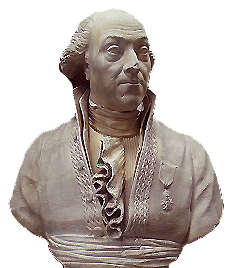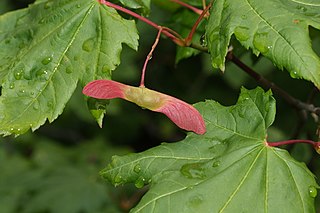
The hybrid elm cultivar Ulmus × hollandica 'Smithii', commonly known as the Downton Elm, was one of a number of cultivars arising from the crossing of the Wych Elm U. glabra with the Field Elm U. minor. The tree was originally planted at Downton Castle near Ludlow, as one of a batch, not all of them pendulous in habit, raised at Smith's Nursery, Worcester, England, from seeds obtained from a tree in Nottingham in 1810.

The elm cultivar Ulmus 'Crispa' [:'curled', the leaf margin], sometimes known as the Fernleaf Elm, arose before 1800 and was first listed by Willdenow as U. crispa (1809). Audibert listed an U. campestrisLinn. 'Crispa', orme à feuilles crépues [:'frizzy-leaved elm'], in 1817, and an Ulmus urticaefolia [:'nettle-leaved elm'] in 1832; the latter is usually taken to be a synonym. Loudon considered the tree a variety of U. montana (1838). In the 19th century, Ulmus × hollandica cultivars, as well as those of Wych Elm, were often grouped under Ulmus montana. Elwes and Henry (1913) listed 'Crispa' as a form of wych elm, but made no mention of the non-wych samara.

The elm cultivar Ulmus 'Berardii', Berard's Elm, was raised in 1865, as Ulmus Berardi, from seeds collected from large specimens of "common elm" growing on the ramparts at Metz, by an employee of the Simon-Louis nursery named Bérard. Carrière (1887), the Späth nursery of Berlin and the Van Houtte nursery of Gentbrugge regarded it as form of a Field Elm, listing it as U. campestris Berardii, the name used by Henry. Cheal's nursery of Crawley distributed it as Ulmus nitens [:Ulmus minor] 'Berardii'. Smith's of Worcester preferred the original, non-specific name, Ulmus 'Berardii'.
The Wych Elm cultivar Ulmus glabra 'Corylifolia' was first described by Host in Flora Austriaca (1827). Another cultivar of the same name is described by Zapalowicz, in Conspectus Florae Galiciae Criticus (1908), but was assumed to be 'Cornuta'.
The elm cultivar Ulmus 'Escaillard' was first described by Dumont de Courset in 1811, and listed, without description, as Ulmus escaillard, by the André Leroy nursery at Angers, France, in 1849. It was distributed by the Baudriller nursery of Angers and by Hesse's nursery, Weener, Germany, as U. campestris 'Escaillardii', both nurseries using U. montana for wych elm cultivars. Herbarium specimens from a tree in The Hague obtained from the Hesse nursery label it variously U. glabra 'Escaillardii' and Ulmus × hollandica 'Escaillardi'. The latter was Christine Buisman's determination (1931), identifiable as hers by its handwriting and red label.
The Wych elm cultivar Ulmus glabra 'Latifolia Aureo-Variegata' was first mentioned by Neubert in Deutsches Magazin für Garten- und Blumenkunde 1871 as Ulmus campestrisL.latifolia aureo-variegata.
The putative Wych Elm cultivar Ulmus glabra 'Latifolia Nigricans' was first described, as Ulmus campestris latifolia nigricans, by Pynaert in 1879. Pynaert, however, did not specify what species he meant by U. campestris. The tree was supplied by the Späth nursery of Berlin in the late 19th century and early 20th as Ulmus montana latifolia nigricans. Späth, like many of his contemporaries, used U. montana both for Wych Elm cultivars and for those of the U. × hollandica group.
The elm cultivar Ulmus 'Rubra' was reputedly cloned from a tree found by Vilmorin in a wood near Verrières-le-Buisson in the 1830s. It was listed in the 1869 Catalogue of Simon-Louis, Metz, France, as Ulmus campestris rubra, and by Planchon in de Candolle's Prodromus Systematis Naturalis Regni Vegetabilis (1873) as Ulmus libero-rubra: 'Orme à liber rouge' [:elm with red inner bark]. Elwes and Henry (1913) and Bean (1936) listed it as Ulmus montana [:U. glabraHuds.] var. libro-rubro, the former stating that the tree appeared "identical" to Simon-Louis's Ulmus campestris rubra. A specimen in the Zuiderpark, The Hague, was identified in 1940 as a wych elm cultivar, U. glabraHuds.libero rubro.
The Elm cultivar Ulmus 'Tiliaefolia' was first mentioned by Host in Flora Austriaca (1827), as Ulmus tiliaefolia [:linden-leaved]. The Späth nursery of Berlin distributed a 'Tiliaefolia' from the late 19th century to the 1930s as neither an U. montana hybrid nor a field elm cultivar, but simply as Ulmus tiliaefolia, suggesting uncertainty about its status. Herbarium specimens appear to show two clones, one smaller-leaved and classified as a field elm cultivar, the other larger-leaved.
The elm cultivar Ulmus 'Rufa' [:rufous-coloured] was listed as U. campestris f. rufa by Georg Dieck, of Zöschen, Germany, without description in Haupt-catalog der Obst- und gehölzbaumschulen des ritterguts Zöschen bei Merseburg, Nachtrag I (1887), though it had been in cultivation for some decades before this date. It was considered "possibly Ulmus carpinifolia" by Green.
Ulmus × hollandica 'Pitteurs' or 'Pitteursii', probably one of a number of hybrid cultivars arising from the crossing of the Wych Elm Ulmus glabra with a variety of Field Elm Ulmus minor, was first identified by Morren as l'orme Pitteurs (1848). Elwes and Henry (1913) and Krüssmann (1976) listed it as an Ulmus × hollandica cultivar. It was named after the landowner Henri Bonaventure Trudon de Pitteurs of Saint-Trond, near Liege, Belgium, who discovered and first propagated the tree on his estate.

The putative Wych Elm cultivar Ulmus glabra 'Latifolia' was identified in Audibert's Tonelle (1817) as U. campestrisLinn. [ = U. glabraHuds.] latifolia. The tree is reputed to have originated circa 1750 in or around Mechelen, and to have been widely planted throughout Belgium. A 1912 herbarium specimen from Oudenbosch, however, shows a hybrid leaf labelled Ulmus hollandica latifolia.
The hybrid elm cultivar Ulmus × hollandica 'Modiolina', or Wheel-hub elm, was probably the large-leaved 'Orme tortillard' first described by Duhamel in De l'exploitation des bois (1764). Poederlé (1774) identified the tree as the 'orme maigre' growing in the region that later became part of Belgium. Dumont de Courset described a small-leaved U. campestris var. modiolina, "l'orme tortillard" in 1802 – the first use of the name 'Modiolina'. 'L'orme Tortillard', also known as 'l'orme à moyeux', was considered in France to be the best elm for use by wheelwrights, its timber especially suitable for hubs of wheels. Van Houtte marketed an U. campestris modiolina (tortuosa), and Späth an U. campestris modiolina, from the late 19th cenry. U. campestris var. modiolinaHort was confirmed as a hybrid by Chevalier in Les Ormes de France (1942) and called U. × 'Modiolina', 'l'orme à moyeux'.
The elm cultivar Ulmus 'Nemoralis' was listed by Schelle in Beissner et al. (1903), as U. campestris f. nemoralisHort. Considered "possibly U. carpinifolia " by Green.
Ulmus boissieriGrudz.,, a disputed species of elm found in Iran, was identified by Grudzinskaya in 1977. She equated her "new species" with the U. campestris f. microphylla collected in 1859 in Kerman Province and described in his Flora Orientalis (1879) by Boissier, for whom she named it, treating Boissier's specimen as the "type". The tree is endemic the provinces of Kermanshah and Kerman., and also the Zagros forests, growing with Quercus brantii, Celtis australis, Platanus orientalis, Fraxinus sp., and Cerasus mehaleb.
Pierre André Pourret (1754–1818) was a French abbot and botanist who did research and teaching in France and Spain. He described and collected large amounts of plant species, especially from the Mediterranean, and amassed many species in his botanical garden and herbarium for his research. Pourret was also a pioneer user of binomial nomenclature, first developed by Carl Linnaeus.
The elm cultivar Ulmus 'Gallica' (Chev.) was described as U. gallica by Auguste Chevalier in 'Les Ormes de France' (1942). A probable hybrid by its suckering habit, it was said to be an elm of central and north-west France and the Paris area. The type tree was said by Déséglise to be seen in Bourges.
The Field Elm cultivar Ulmus minor 'Monumentalis', the tomb elm (Grabmal-Rüster), was raised as a sucker of U. suberosa by Sebastian Rinz, the city gardener of Frankfurt, and described as U. campestris var. monumentalisRinz, 'Pyramid Field Elm', by Kirchner (1864), who said it had only recently been propagated by Rinz and established in the nursery. It was distributed from the 1880s by the Baudriller nursery, Angers, and by the Späth nursery, Berlin, as U. campestris monumentalisRinz., appearing separately in their catalogues from U. minor 'Sarniensis', the Guernsey or Wheatley Elm, with which, according to Henry, it was confused on the continent. Krüssmann, for example, gives 'Monumentalis' as a synonym of 'Sarniensis'. 'Sarniensis' is known as monumentaaliep [:monumental elm] in The Netherlands. Springer noted that the Dutch monumentaaliep was "not the actual monumentaaliep but U. glabraMill.var. Wheatleyi Sim. Louis", and that it "should be renamed U. glabraMill. var. monumentalisHort.(non Rinz)". In England, Smith's of Worcester listed Ulmus monumentalis separately from Ulmus 'Wheatley' in the 1880s.
The elm cultivar Ulmus 'Betulaefolia Nigrescens', the Black Birch-leaved Elm, reportedly a seedling of a purplish-leaved elm, was first described by Pynaert in 1879 as U. campestris betulaefolia nigrescens. An U. campestris betulaefolia nigrescensHort. was distributed by the Späth nursery, Berlin, in the 1890s and early 1900s.







